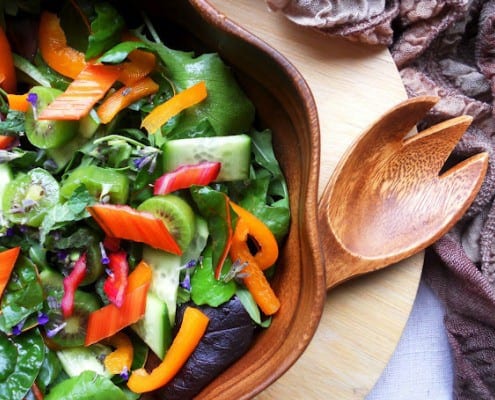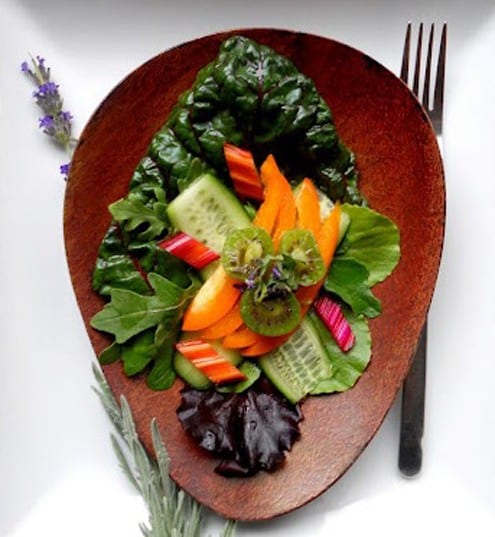Spring is here and there is no easier time to “Eat Your Colors”.
By Alisha Randell
Both the farmers’ markets, as well as our gardens are exploding with color right now. And aside from being aesthetically appealing there are some potential health benefits that come along with it. Adding an array of colorful plants to your diet might just benifit more than your mood.
Phytochemicals, or more commonly know as antioxidants, play a key role in helping to protect our cells from damage. The variety of chemical compounds that make up phytochemicals, are also responsible for giving our fruits, vegetables and other plants their color.
Research tells us that a variety of foods have many different compounds and each work differently on our cells. As an example of a couple of these components that make up phytochemicals, are vitamins E and C. We know that citrus fruits, dark leafy greens and bell peppers are all good sources for vitamin C. While many of our nuts and seeds are high in vitamin E.
Of course the list goes on, but we can clearly see why adding a variety of colorful foods to our diet can have a healthful impact. If you would like to get more detailed information on the benefits of colorful foods, this article from the American Cancer Society or this article from The University of Maryland Medical Center are two I found helpful.
Whether you garden or not there is no better time to add some color to your world.
PrintAn Organic Gardener’s Salad
- Total Time: 25 minutes
- Yield: 4 1x
Ingredients
- 1/4th pound (112.5g) young rainbow chard, (leaves and stems sliced)
- 1 small bunch arugula leaves, trimmed
- 1/4th pound (112.5g) baby romaine leaves
- 4 baby cucumbers, thinly sliced
- 16 Baby kiwi, halved
- 1 Tbs (15 ml) Lavender flowers
- 6-8 Apple mint leaves, torn
- 1 large orange bell pepper, sliced
- 1/8th cup (30ml) fresh lemon, orange and lime juice combined
- 1/4th cup (60ml)Sunflower oil
- 1 tsp (4g)raw sugar
- Salt and Pepper to taste
Instructions
- Trim the stems of your chard, and slice up like you would celery.
- Tear or roughly chop all of your greens and apple mint.
- Use a madoline slicer or sharp pairing knife to thinly slice cucumbers lengthwise.
- Peel and halve baby kiwi.
- Thinly slice bell pepper.
- Add fruits and vegetables to a mixing bowl, or layer out on individual plates.
- Prepare your dressing by adding freshly squeezed juices to a small bowl, while slowly adding oil.
- Add salt and pepper, whisking until incorporated.
- Add lavender flowers or other edible flowers.
- Toss salad with dressing, or drizzle onto individual salads
Notes
Use whatever seasonal fruits and vegetable are available to you, but try to add as much variety of color that you can
- Prep Time: 15 mins
- Cook Time: 10 mins















Without specific knowledge of their cellular actions or mechanisms, phytochemicals have been considered as drugs for millennia. For example, Hippocrates may have prescribed willow tree leaves to abate fever. Salicin, having anti-inflammatory and pain-relieving properties, was originally extracted from the bark of the white willow tree and later synthetically produced became the staple over-the-counter drug aspirin.^”^..
Best regards
<http://www.healthmedicinejournal.com/index.php
Gorgeous vibrant colors and incredibly healthy! Gardening is a big part of my life – lovely post for Earth Day or any day!
Hi Vicki, thank you so much :) I love to garden as well…
What a beautiful photo! Makes me want to make this for lunch today. I grow a lot of veggies in my garden, but I was inspired by Mother Nature & Earth Day, to eat something that was organically & wild grown, therefor all of us enjoy…the dandelion. Come see how good this little pest can taste. :) http://watching-what-i-eat.blogspot.com/2012/04/cooking-with-dandelions-fritters.html
This looks great. I can’t wait to make it. Do you think it works with olive oil?
Hi Simone, yes it should work fine but probably a light olive oil versus an extra virgin. That would be less likely to compete with the fresh juices.